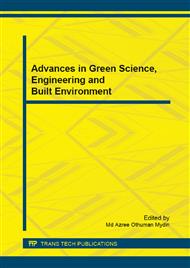p.306
p.310
p.313
p.317
p.321
p.325
p.329
p.333
p.337
Maintenance Performance Quadrant for Rainwater Harvesting System
Abstract:
Maintenance performance is a key aspect in sustaining the RWH system. This is to ensure the maximum value of installing the RWH system as well as ensuring the system performs throughout the building's lifetime. Two instruments were used during this research namely physical condition survey and questionnaire survey. The results from both instruments demonstrated cross-combination finding via maintenance performance quadrant at the end of analysis. Based on the study at 16 government buildings throughout Malaysia, the results show the majority of buildings need improvement in terms of their maintenance management, while two buildings have bad practice, which needs total refurbishment for the RWH system as well as their maintenance management. In conclusion, the physical condition of the RWH system for government building in Malaysia is regarded good and safe implemented. However, the maintenance performance can be improved with a proper maintenance guideline and management policy by the organization involved.
Info:
Periodical:
Pages:
321-324
Citation:
Online since:
March 2015
Authors:
Price:
Сopyright:
© 2015 Trans Tech Publications Ltd. All Rights Reserved
Share:
Citation:


